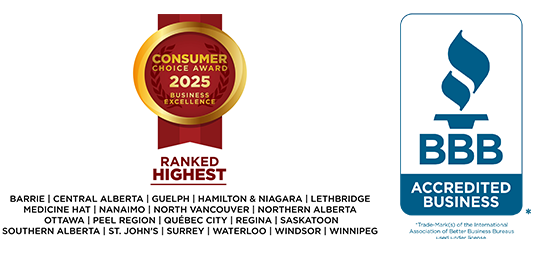How are Consumer Proposal fees determined?
For a consumer proposal to be viable, your creditors will generally expect to receive more money than they would in a bankruptcy scenario. This usually means you need to be capable of monthly payments over an extended period of time which are sufficient to resolve your outstanding debts; although it may be possible to negotiate a proposal that requires you to pay a lump sum within some reasonable time frame.
Once you decide to move forward with a Consumer Proposal, your Licensed Insolvency Trustee will file notice with the Office of the Superintendent of Bankruptcy (OSB) — proposing new terms for your debts (e.g. lower interest rates, lower monthly payments, extended payment terms, etc.). At that moment, interest stops accumulating, you stop making payments on your outstanding balances and most wage garnishments will cease. Once a majority (by dollar value) of creditors accept the terms, all future debt payments will be made in monthly installments to your Licensed Insolvency Trustee or as set out in the proposal. He or she will then disburse those funds to your creditors.
The fees associated with your consumer proposal are federally regulated and are a percentage of the funds you pay into your proposal. From your first meeting until your proposal is paid off, you will never be billed directly for any services.
How will a Consumer Proposal impact my credit score?
The process of filing a Consumer Proposal is intended to help you settle your debts without the long-term consequences and relinquishing of assets associated with a personal bankruptcy. With that said, there will be some immediate impacts to your credit score which you should be aware of. These will affect your ability to borrow money for the first few years after your claim.
For three years after your final payment, a note will appear on your credit report indicating that you entered into an arrangement to settle your debts. This will make it more difficult to secure new loans, credit cards, and other forms of financing. It may cause lenders to require a co-sign to issue new debt or mean you will be charged higher interest rates if you do get approved.
There are things you can do during and after the filing of your proposal that will improve your credit score, even while you are still making payments into the proposal. Those will be explained to you during the two counselling sessions that are conducted as part of the consumer proposal process.
How Much Will a Consumer Proposal Cost?
When it comes to costs involved in filing a Consumer Proposal, there are a couple of important points. First, costs are
federally regulated and prescribed by a tariff contained in insolvency legislation. Second, all costs associated with filing
a Consumer Proposal are paid from the Proposal funds, so the consumer is not billed for costs at any time during the
Proposal. In effect, the Proposal funding covers administration costs and payments to creditors.
| What? |
How Much? |
Who? |
| Filing fee |
$104.24 |
Office of the Superintendent of Bankruptcy |
| Counselling Fees |
$170.00 (2 sessions x $85.00) plus applicable taxes
|
Licensed Insolvency Trustee or third-party qualified counsellor |
| Proposal Administration Fees |
$1,500 flat fee plus 20% of creditor distributions, plus applicable taxes |
Licensed Insolvency Trustee |
| Levy |
5% of creditor distributions, deducted from payments to creditors |
Office of the Superintendent of Bankruptcy |
To have your Consumer Proposal accepted, it needs to be a better outcome for your creditors than if you were to file a bankruptcy. How much of your debt you’ll repay will depend in part on your income level and what assets you own.
To illustrate the costs associated with filing a Consumer Proposal, here is a breakdown of the costs and distributions associated with a Consumer Proposal offering payments totalling $20,000.00
| Proposal funds |
$20,000.00 |
| Less: Filing fee |
$104.24 |
| Less: Counselling fees |
$170.00 |
| Less: Tax on counselling fees (5%) |
$8.50 |
| Less: Initial LIT fees |
$1,500 |
| Less: Tax on LIT fees (5%) |
$75 |
| Amount available for distribution |
$18,142.26 |
| Less: LIT fees on distributions (20%) |
$3,628.45 |
| Less: Tax on LIT fees (5%) |
$181.42 |
| Less: Levy on creditor distributions (5%) |
$716.62 |
| Net amount payable to creditors |
$13,615.77 |
The timing of costs involved in a Consumer Proposal is also prescribed by insolvency legislation. The filing fee payable to the government is due upon filing the Proposal, and the costs of counselling are payable as the counselling sessions are completed. The initial Licensed Insolvency Trustee (LIT) fee of $1,500 consists of two separate draws: the Licensed Insolvency Trustee is eligible to draw $750 upon filing the Proposal and $750 upon court approval of the Proposal as soon as Proposal funds become available. In other words, if the Consumer Proposal calls for monthly payments of $300, it will take more than a year for the Licensed Insolvency Trustee to receive payment for these initial fees.
Creditors typically begin to receive distributions after payment of the filing fee, initial Licensed Insolvency Trustee fees, and counselling fees. The Consumer Proposal must set out how often creditors will receive distributions. Each time a distribution is made to creditors, the Licensed Insolvency Trustee receives 20 percent of the distribution, plus applicable taxes, and five percent is deducted from the creditor payments for payment to the Superintendent of Bankruptcy.
The total cost to you will be equal to or lower than what you owe your creditors at the moment your Consumer Proposal is filed — less the accumulated interest and penalties that would have been incurred had you not entered a Consumer Proposal.



